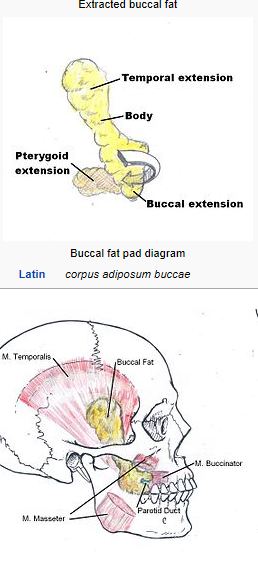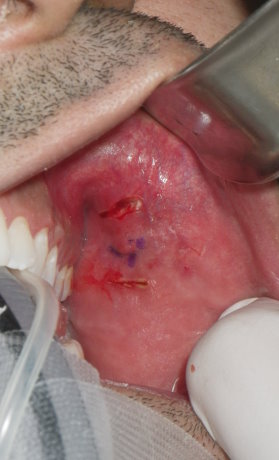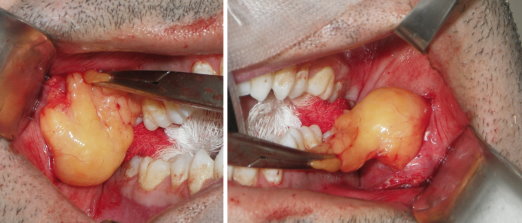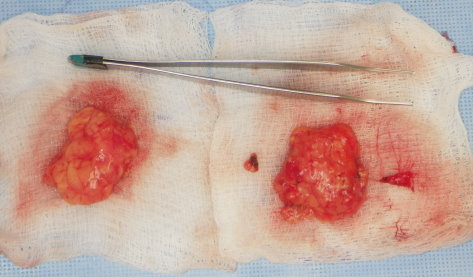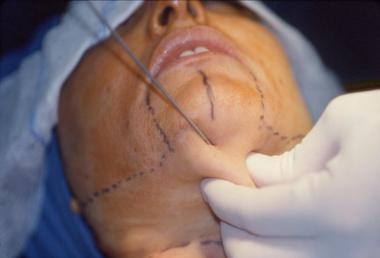Head and Neck Liposuction
Facial and neck liposuction can produce very dramatic effects in the aging face or in younger patients with fat deposits. Liposuction is not a substitute for weight loss. Suctioning fat deposits on an over-weight person will create a deformity because the removal of fat will result in baggy skin.
Although liposuction is a common term, the procedure is actually more properly referred to as liposculpture. The word sculpture indicates an actual artistic recontouring of the fat instead of just removing fat. Although excess fat removal is a positive change, taking away too much fat can leave unpleasant cosmetic deformities. Fat is not always the enemy and leaving the proper amount of fat under the skin is extremely important.
Liposuction, however, is an excellent means of removing fat deposits in individuals whom have genetic fat deposits or fat collections from aging. The most effective areas for facial liposuction are the areas under the chin and the jowls, which are the droopy areas that form on the sides of the jaws as we age.
Fat deposits in the chin, neck and jowls can be reduced with simple liposuction if the is not excessive excess skin. The picture on the right shows a Hollywood “fat suit” where latex is used to mimic the common areas of face and neck fat.
Small precision micro liposuction cannulas are used with a suction machine to remove the unwanted fat. The procedure is done through a small puncture hidden under the chin.
Dr. Arul uses a combination of surgical procedures when performing liposuction. Frequently a chin implant is utilized with the liposuction under the chin. This tightens up the loose skin and enhances the patient’s profile. In addition, Dr. Arul may elect to perform a neck lift procedure in which he corrects the sagging muscles of the neck to restore their youthful position. This is effective in improving the “turkey gobbler” deformity of the neck.
It is important to mention that if significant loose skin is present, liposuction by itself may produce disappointing results. For cases with a large amount of skin, a face lift procedure may be required.
Most of this surgery may be done in the office under local or IV anesthesia.
Depending upon the severity of the deformity, the recovery time for these surgeries is from 3-7 days. Patients wear a support head wrap to compress the treated areas. This is worn for several days continually and at night for 5-7 days.
The pictures below show a case of liposuction with simultaneous chin implant. Although there is significant improvement with a happy patient, the liposuction does not totally addresses skin excess. A face or neck lift would be required to totally address the skin. This patient, like some patients, wanted a change but did not want a facelfit procedure.
The above patient underwent sliding genioplasty (chin lengthening) and submental (under the chin and neck) liposuction
Buccal Fat Pad Reduction
Buccal fat pad reduction (also called Bichat’s fat pad) is a common cosmetic facial surgery procedure that is performed to slim the cheeks or face. Notice I refer to this as buccal fat pad reduction and not buccal fat removal. I never recommend removing all the fat. More about that later.
The buccal fat pads (buccal refers to the Latin word Bucca meaning cheek) are walnut sized fat deposits deep in the cheeks. These fat masses are located in the cheek between the nostril and corner of the mouth. Their function is to assist nursing in infants or to provide a smooth gliding plane for the jaw muscles. It is the large buccal fat pads that give infants and young children the cheeks that grandma likes to pinch. It is also the atrophy of these areas that cause the gaunt faces of anorexia, HIV or starvation.
Some patients have a very full and round face, in part from large buccal fat pads. The buccal fat pad is a large unit with mass in the temple region, the cheek region and the pterygoid region (back of the upper jaw). There is no indication to remove the entire buccal fat pad and it is the cheek region that is most frequently reduced. I always warn about total removal as it will slim the face, but a decade later can lead to a very gaunt and unhealthy appearance. Remember, you have to live with your face the rest of your live and all fat is not “bad fat”.
I most commonly see patients requesting buccal fat reduction that have chubby cheeks in relation to the rest of their face and body. It is frequently hereditary. Although you occasionally hear about liposuction of the buccal fat pads, I don’t ever do this for several reasons. Number one, these pads have heavy fibrous capsules that do not lend themselves to common liposuction. More importantly, facial nerve branches, the anterior facial vein and parotid duct are frequently in close approximation to these fat pads and could be injured producing facial paralysis or severe bleeding. For this reason, I always perform a magnification assisted precision surgical reduction of the fat pads. It is not an area for imprecise technique and it is important for patients to select a surgeon with lots of experience and expertise in facial surgery.
The fat is located by making several small incisions on the inside of the cheek. The surgeon then locates the buccal extension of the fat pad which is generally very plentiful and protrudes into the mouth . The amount of fat to be removed is determined and the fat pad is removed using a laser or radiowave device. This is important as it seals the blood vessels and prevents bleeding which can be problematic in that area. After the fat is removed the small incisions are closed with dissolving sutures (see figures below).
This figure shows a drawing of the location of the entire buccal fat pad within the face.
This photo below shows the incisions for buccal fat reduction.
The photo below shows the fat after dissection and before removal.
The photo below shows the excised fat on an average patient.
The recovery is generally 3-5 days and some patients swell significantly while others don’t. Although the result is immediately noticeable, the final result won’t be evident for several weeks when all swelling is gone. This procedure will generally produce a slimming of the cheeks in the area lateral to the nostril and corner of the mouth. In some patients it is a very noticeable change and in others, it is minimal. While most patients are very happy with the results, some patients wish the results were more dramatic. Again, this is a procedure that demands some level of surgical conservatism as over correction can produce a very hollowed and unhealthy look. As stated earlier, this effect may not s how up for years in the future. Conservative removal has remained a safe and predictable procedure in my practice.
The procedure takes about 20 minutes per side and is performed with IV anesthesia. This procedure may be performed with other cosmetic facial procedures such as facial implants, liposuction, or facelift surgery.
Liposuction of the Face and Neck
Cervicofacial liposuction involves the application of negative pressure through a hollow cannula in the subcutaneous plane to gently avulse fat cells and precisely sculpt undesirable fat deposits in the face and neck. In combination with other facial plastic and reconstructive procedures, lipocontouring provides a versatile tool in the facial plastic surgeon's armamentarium for achieving the desired facial profile
The image below depicts liposuction of the face and neck.
The skin is tented and fed with the opposite hand in order to ensure smooth passage of the suction cannula in the appropriate subdermal plane.




